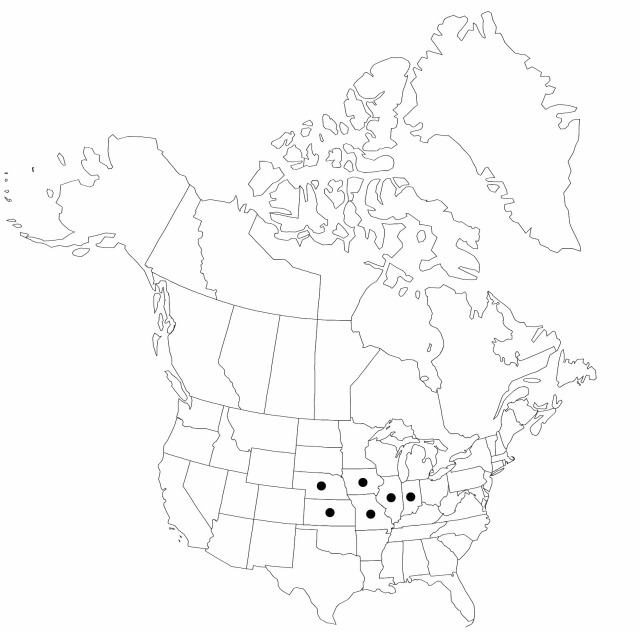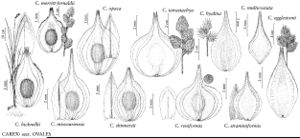Difference between revisions of "Carex missouriensis"
Novon 11: 220, figs. 1(left), 3C, 4, 10. 2001.
FNA>Volume Importer |
imported>Volume Importer |
||
| (3 intermediate revisions by 2 users not shown) | |||
| Line 31: | Line 31: | ||
-->{{#Taxon: | -->{{#Taxon: | ||
name=Carex missouriensis | name=Carex missouriensis | ||
| − | |||
|authority=P. E. Rothrock & Reznicek | |authority=P. E. Rothrock & Reznicek | ||
|rank=species | |rank=species | ||
| Line 46: | Line 45: | ||
|publication year=2001 | |publication year=2001 | ||
|special status= | |special status= | ||
| − | |source xml=https:// | + | |source xml=https://bitbucket.org/aafc-mbb/fna-data-curation/src/2e0870ddd59836b60bcf96646a41e87ea5a5943a/coarse_grained_fna_xml/V23/V23_664.xml |
|genus=Carex | |genus=Carex | ||
|section=Carex sect. Ovales | |section=Carex sect. Ovales | ||
Latest revision as of 20:42, 5 November 2020
Plants densely cespitose, to 200 culms together; rhizomes may appear elongate in old clumps. Culms 45–90 cm; vegetative culms few, inconspiculous, usually fewer than 12 leaves, not strikingly 3-ranked. Leaves: sheaths glabrous, individually indistinct Y-shaped hyaline band reaching 0–8 mm below the collar, summit U-shaped or truncate, extending 0–2 mm beyond collar, smooth; distal ligules 2–4 mm; blades 3–6 per fertile culm, 2.5–25 cm × 1.8–3.2(–4) mm. Inflorescences open to congested, erect to nodding, pale or golden brown, 2–4.5 cm × 7.5–19 mm; proximal internode 3.5–12 mm; 2d internode 3–10 mm; proximal bracts scalelike or often with bristle tips shorter than or equaling inflorescences. Spikes 3–8, distant, distinct, globose to ovoid or conic, 8–14 × 4.5–9.5 mm, base rounded to acute, apex acute, obtuse, or rounded. Pistillate scales pale yellowish brown or occasionally copper-brown tinged, with narrow yellow-brown midstripe, lanceolate or lance-ovate, 3.7–4.4 mm, reaching base to middle of perignyium beaks, margin whitish to brownish hyaline, apex membranaceous, curled, acuminate or awned to 0.7 mm. Staminate scales acuminate-awned. Anthers (1.8–)2.2–3.6 mm. Perigynia 15–80 on larger spikes, loosely ascending, light green, yellow-brown, or copper-brown, green or brown winged, inconspicuously 0–3(–5)-veined adaxially, 0–8-veined abaxially, 1–2 veins in winged margin, broadly elliptic to ovate, flat or concavo-convex except over achene, (4.2–)4.6–6.7(–7.1 in larger perigynia) × 2.5–4 mm, 0.5–0.7 mm thick, herbaceous, ± opaque, with achene not visible through adaxial face, margin flat, including wing 0.6–1.1 mm wide smooth; beak tip, strongly flattened, 2–2.8 mm, serrulate-margined to apex, abaxial suture pale or copper-brown, distance from beak tip to achene 2.6–4.2 mm. Achenes elliptic to ± orbiculate, 1.6–2.2 × 1.2–1.6 mm, 0.5–0.7 mm thick, apiculum to 0.4–1.1 mm. 2n =50, 52, 54.
Phenology: Fruiting early summer.
Habitat: Prairie swales
Elevation: 100–400 m
Distribution

Ill., Ind., Iowa, Kans., Mo., Nebr.
Discussion
Selected References
None.
